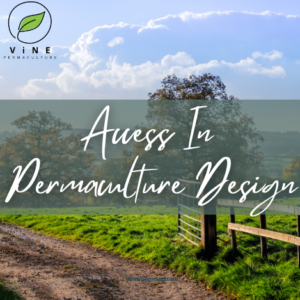How does permaculture design address access for animals, people and vehicles on a property?
Observation of traffic patterns, water management, and Zonal Design are a few techniques used to maximize access to the property.
In permaculture design, sector analysis plays a crucial role in understanding and incorporating various external factors that influence a site. When considering access for vehicles and people, permaculture designers take into account the movement patterns and needs of both vehicles and individuals within and around the site. By analyzing these factors, designers can optimize accessibility, minimize resource use, and create efficient pathways that harmonize with the natural landscape. In this essay, we will explore five key points on how permaculture design sector analysis considers access for vehicles and people.
Observing Traffic Patterns:
Permaculture sector analysis is a comprehensive approach to design that considers various external influences on a system. One aspect of sector analysis involves observing traffic patterns, which can provide valuable insights for designing efficient and functional permaculture systems.
When observing traffic patterns, permaculture designers pay attention to the movement of people, animals, and vehicles in and around the site. This includes pedestrian footpaths, animal migration routes, and vehicle access points. By understanding these patterns, designers can strategically position elements within the system to maximize accessibility, minimize disruptions, and enhance overall efficiency.
For example, in a residential permaculture design, observing foot traffic patterns can inform the placement of pathways, garden beds, and gathering spaces. By aligning pathways with the natural flow of movement, designers can create intuitive and convenient routes that encourage efficient navigation and minimize unnecessary disturbances.
Similarly, in an agricultural permaculture system, observing the movement of livestock can influence the location of paddocks, grazing areas, and watering points. By considering animal traffic patterns, designers can minimize soil compaction, optimize forage availability, and promote healthier grazing practices.
Furthermore, observing vehicle traffic patterns is crucial for designing functional access points, driveways, and parking areas within a permaculture site. Understanding how vehicles enter and exit the site, as well as their typical routes, enables designers to create safe and efficient transportation networks that integrate seamlessly with the overall design.
By incorporating observations of traffic patterns into permaculture sector analysis, designers can create systems that harmonize with existing movement patterns, optimize accessibility, and minimize disruptions. This holistic approach ensures that permaculture systems not only function effectively but also seamlessly integrate with the broader landscape and community.
Designing for Multi-modal Transportation:
Permaculture sector analysis recognizes the importance of designing for multi-modal transportation as a crucial element in creating resilient and sustainable systems. By considering transportation as a key sector, permaculture design aims to minimize reliance on fossil fuels, reduce carbon emissions, and promote alternative modes of transportation.
Designing for multi-modal transportation involves integrating various transportation options, such as walking, cycling, public transit, and carpooling, into the overall design of a permaculture system. This approach prioritizes accessibility and connectivity, ensuring that different parts of the system can be easily reached without the need for private vehicles. Pathways, trails, and infrastructure are strategically planned to facilitate safe and efficient movement.
By encouraging non-motorized transportation modes, permaculture systems promote physical activity, enhance community engagement, and reduce the ecological footprint associated with transportation. In addition, permaculture designs may incorporate amenities like bicycle storage, car-sharing programs, or electric vehicle charging stations to accommodate alternative transportation choices.
Considering multi-modal transportation in permaculture design also fosters a stronger connection between people and their surrounding environment. By designing walkable and bike-friendly communities, individuals have the opportunity to engage with nature, observe ecological processes, and appreciate the local ecosystem.
In conclusion, permaculture sector analysis recognizes the significance of designing for multi-modal transportation as an integral part of creating sustainable and resilient systems. By prioritizing accessibility, connectivity, and alternative transportation modes, permaculture design not only reduces reliance on fossil fuels but also fosters healthier, more vibrant communities.
Integrating Access with Zones and Elements:
Permaculture sector analysis considers the integration of access with zones and elements to create efficient and functional designs. Access refers to the pathways, roads, and routes that allow movement within a permaculture site. Zones represent different areas of the site that are organized based on frequency of use and intensity of management. Elements include various components such as buildings, gardens, water features, and livestock.
Integrating access with zones and elements in permaculture design ensures that movement and interaction within the site are optimized while minimizing unnecessary disruptions. By strategically planning the placement of access routes, paths, and roads, designers can create efficient pathways that connect different zones and elements, allowing easy movement and accessibility for maintenance, harvesting, and observation.
The integration of access with zones also considers the frequency of use and management intensity of each zone. Zones that require regular attention, such as vegetable gardens or animal pens, should be located closer to the main access points, while zones with less frequent management, such as orchards or wild areas, can be placed farther away. This arrangement reduces the time and effort required for accessing and managing different zones, promoting efficiency and productivity.
Furthermore, the integration of access with elements involves thoughtful placement of infrastructure and features within the site. Buildings, water catchment systems, or livestock shelters should be strategically positioned to optimize accessibility and minimize energy expenditure. For example, placing a rainwater harvesting system near the main access route simplifies maintenance and enhances water management efficiency.
In conclusion, permaculture sector analysis emphasizes integrating access with zones and elements to create well-designed, functional systems. By considering the flow of movement, frequency of use, and management intensity, permaculture designers ensure efficient access to different zones and elements. This integration enhances productivity, reduces energy expenditure, and promotes a harmonious interaction between humans, plants, animals, and the environment within a permaculture site.
Incorporating Water Management:
Permaculture sector analysis is a valuable tool that permaculture practitioners use to access and design their systems based on various factors that influence the site. Water management is a crucial aspect integrated into this analysis. Recognizing the significance of water and its role in sustaining life, permaculture sector analysis assesses the patterns and flows of water in the landscape.
Water management in permaculture sector analysis involves identifying water sources, such as rainfall, rivers, or groundwater, and understanding their availability and accessibility throughout the year. It also considers the movement of water across the site, including surface runoff, drainage patterns, and potential areas of water accumulation. By understanding these factors, designers can strategically plan the placement of elements in the landscape to effectively capture, store, and distribute water.
Permaculture sector analysis also takes into account external influences on water management, such as neighboring properties, prevailing winds, and potential contaminants. By considering these factors, designers can implement measures to protect water quality and prevent water pollution.
Furthermore, permaculture sector analysis considers the microclimates and microhydrology of the site. This involves identifying areas prone to erosion, waterlogging, or drought and developing strategies to mitigate these issues. Techniques such as swales, contouring, and keyline design are employed to slow down water movement, retain moisture in the soil, and prevent soil erosion.
Overall, water management is an integral part of permaculture sector analysis. By understanding and working with the natural patterns and flows of water, permaculture systems can enhance water efficiency, promote ecosystem health, and create sustainable water management practices.
Enhancing Safety and Security:
One key aspect of enhancing safety and security in access is creating well-defined pathways and entrances. Clearly marked and properly maintained access points ensure that people can navigate the permaculture site safely and efficiently. This includes pathways that are wide enough for easy movement, with clear signage and lighting where necessary, to prevent accidents or confusion.
In addition to physical pathways, permaculture design can integrate security measures to safeguard against potential risks. This may involve the installation of fences, gates, or other barriers to control access and protect the site from unauthorized entry. Using natural materials such as thorny bushes or dense plantings can serve as effective deterrents while blending harmoniously with the surrounding landscape.
Furthermore, incorporating appropriate lighting and surveillance systems can enhance security, especially during nighttime hours. Strategically placed lights can improve visibility and discourage trespassers, while surveillance cameras can help monitor activities and deter potential threats.
Lastly, designing access routes that consider emergency situations is essential. Planning for multiple exit points and ensuring that emergency services can access the site easily is crucial for the safety of individuals within the permaculture project.
Overall, by prioritizing safety and security in access design, permaculture practitioners can create resilient systems that not only support sustainable living but also foster a sense of well-being and protection for all stakeholders involved.
Resources:
Using a Permaculture Principle to fix a Problem with Access around the Farm –
https://www.youtube.com/watch?v=YP2WN0T4u8c



